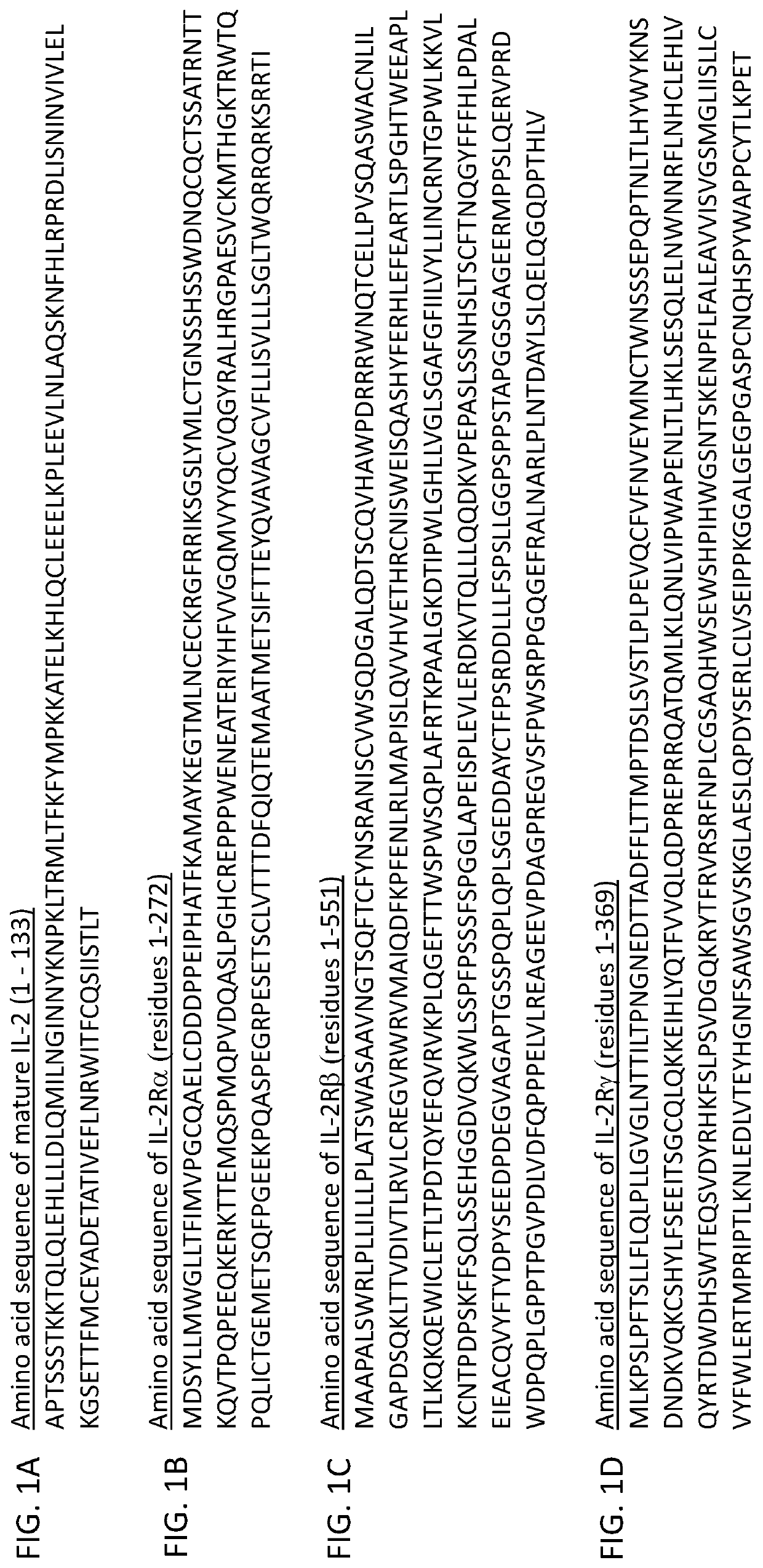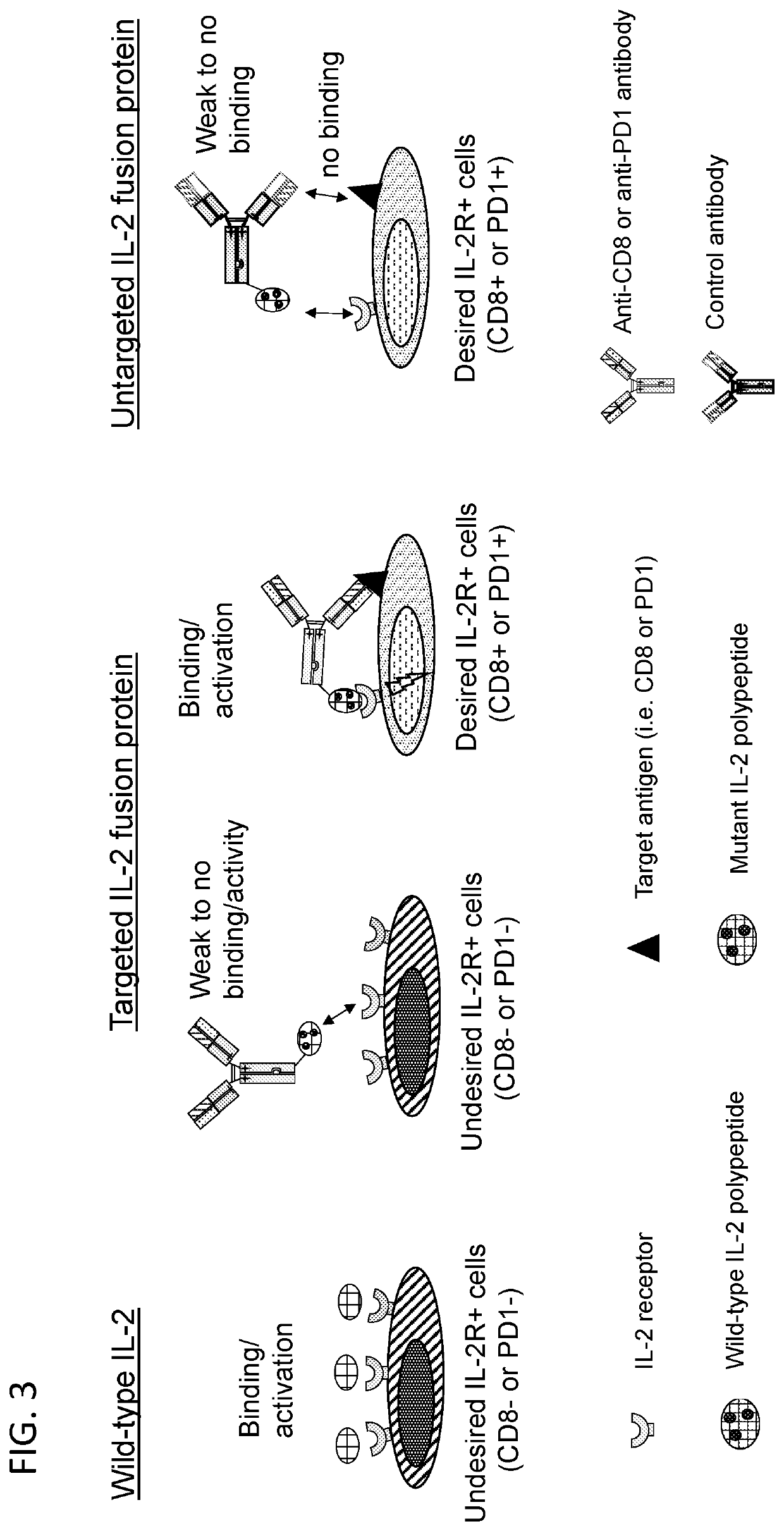Fusions of mutant interleukin-2 polypeptides with antigen binding molecules for modulating immune cell function
a technology of antigen binding and interleukin-2, which is applied in the direction of peptide/protein ingredients, drug compositions, pharmaceutical active ingredients, etc., can solve the problems of severe toxicity and the benefit of il-2 in patients, and achieve the effects of reducing the pleiotropic effect of il-2, reducing the effect of il-2, and reducing the toxicity of il-2 polypeptides
- Summary
- Abstract
- Description
- Claims
- Application Information
AI Technical Summary
Benefits of technology
Problems solved by technology
Method used
Image
Examples
example 1
Recombinant DNA Techniques
[0132]Techniques involving recombinant DNA manipulation were previously described in Sambrook et al., Molecular cloning: A laboratory manual; Cold Spring Harbor Laboratory Press, Cold Spring Harbor, N.Y., 1989. All reagents were used according to the manufacturer's instructions. DNA sequences were determined by double strand sequencing.
Gene Synthesis
[0133]Desired gene segments were either generated by PCR using appropriate templates or synthesized at Thermo Scientific (Pleasanton, Calif.), ATUM (Newark, Calif.), Genewiz (South Plainfield, N.J.), or GeneScript (Piscataway, N.J.) from synthetic oligonucleotides. The gene segments flanked by designed restriction endonuclease cleavage sites were digested out and later cloned into their respective expression vectors. DNA was purified from transformed bacteria and concentration determined by UV visible spectroscopy. DNA sequencing was used to confirm the DNA sequences of the subcloned gene fragments.
Isolation of ...
example 2
f IL-2 and IL-2 Variants to Activate Splenic Cell Subsets
[0143]This example describes experiments to test the capacity of IL-2 fusion compounds to activate STAT5 in mouse NK cells and to induce NK-mediated toxicity in mice.
[0144]The ability of IL-2 and IL-2 variants with reduced binding to CD25 / IL2Rα to activate splenic cell subsets was tested with a STAT5 assay. IL-2 and a previously published IL-2 variant (IL-2v) fused to control antibody (xHA), xHA-IL-2v, were used to stimulate mouse splenocytes containing CD8 T cells, CD4 T cells and NK cells. STAT5 activation in different splenic subsets was measured by flow cytometry, as described in Example 1. CD8 T cells were identified in the CD3+CD4− gate / subset, Treg cells were identified as CD3+CD4+CD25+, and NK cells were identified as CD3-CD49b+.
[0145]FIG. 5 shows the results of this experiment. NK cells were ˜10× more sensitive to IL-2 stimulation than CD8+ T cells, while Treg cells were the most sensitive (FIG. 5 at left). In the cas...
example 3
ization of Anti-Mouse CD8 Antibodies
[0148]This example describes the characterization of anti-mouse CD8 antibodies.
Results
[0149]The binding affinity of anti-mouse CD8 antibodies was determined through flow cytometry analysis. Fresh splenocytes were incubated with the either xCD8ab1 (clone 2.43), xCD8ab2 (clone YTS156.7.7) or xCD8ab2.1 for 2 hours at 4° C. xCD8ab1 (clone 2.43) and xCD8ab2 (clone YTS156.7.7) sequences have been previously published. The xCD8ab2.1 clone is derived from xCD8ab2 by introduction of mutations N95A (VH) and D92A (VK). After incubation with the anti-mouse CD8 antibody, the cells were then stained with antibodies against CD3, CD4, CD8 and anti-hFc (HP6017, Biolegend), the latter of which was used to measure the binding of CD8-IL2 fusion containing hFc. Stained cells were washed and analyzed by flow cytometry and mean fluorescence intensity (MFI) of staining with anti-hFc was used to denote binding. As shown in FIG. 7, xCD8ab2 had a higher affinity for CD8+ T ...
PUM
 Login to View More
Login to View More Abstract
Description
Claims
Application Information
 Login to View More
Login to View More - R&D
- Intellectual Property
- Life Sciences
- Materials
- Tech Scout
- Unparalleled Data Quality
- Higher Quality Content
- 60% Fewer Hallucinations
Browse by: Latest US Patents, China's latest patents, Technical Efficacy Thesaurus, Application Domain, Technology Topic, Popular Technical Reports.
© 2025 PatSnap. All rights reserved.Legal|Privacy policy|Modern Slavery Act Transparency Statement|Sitemap|About US| Contact US: help@patsnap.com



